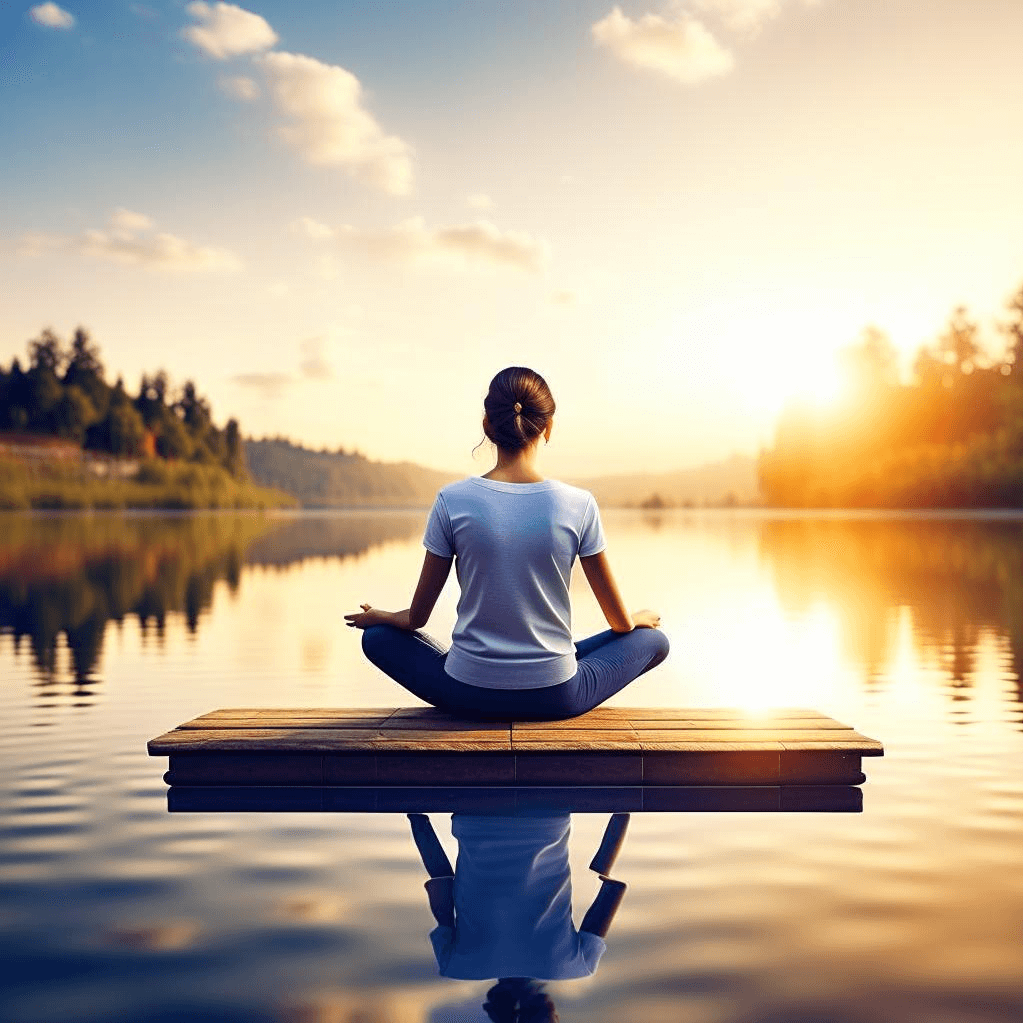In today’s fast-paced world, finding peace and tranquility can be a challenge. But did you know that there’s a simple practice that can help you achieve a state of peaceful awareness? It’s called mindfulness meditation, and it’s gaining popularity for its ability to bring calm and clarity to our busy lives. In this beginner’s guide, we’ll explore the world of mindfulness and meditation, and discover how you can start practicing peaceful awareness today. So, grab a comfortable seat and get ready to embark on a journey towards inner peace and tranquility.
Contents
I. Understanding Mindfulness and Meditation
II. Getting Started with Mindfulness Meditation
III. Techniques for Practicing Mindfulness Meditation
IV. Overcoming Common Challenges
V. Integrating Mindfulness into Daily Life
VI. Additional Resources and Support
VII. Conclusion
I. Understanding Mindfulness and Meditation

Mindfulness is all about being present and fully aware of the present moment. It’s like giving your brain a little vacation from all the worries and distractions. Studies show that practicing mindfulness can reduce stress, improve focus, and boost overall well-being. So, it’s basically a superpower for your mind!
Now, let’s talk about meditation. It’s like a workout for your brain. You sit or lie down, close your eyes, and focus on something like your breath or a calming sound. This helps you train your mind to stay in the present moment and not get caught up in thoughts or worries. It’s like hitting the reset button for your brain!
When you practice mindfulness meditation, you’re combining the power of mindfulness and meditation. It’s like a double whammy of relaxation and mental clarity. By being fully present and focusing on your breath or body sensations, you can cultivate a state of peaceful awareness. It’s like finding a secret hideaway in your mind where everything feels calm and serene.
So, whether you’re dealing with stress, anxiety, or just want to improve your overall well-being, practicing mindfulness meditation is a great way to find that inner peace. It’s like giving your mind a spa day and coming out feeling refreshed and rejuvenated. So, why not give it a try and see how it can transform your life?
II. Getting Started with Mindfulness Meditation

If you’re ready to embark on a journey towards peaceful awareness through mindfulness meditation, here are some simple steps to get started:
1. Create a peaceful and comfortable environment for meditation: Find a quiet and clutter-free space where you can sit comfortably. You can use cushions or a chair to support your posture. Dim the lights or use candles to create a soothing ambiance.
2. Choose a suitable meditation technique for beginners: There are various techniques you can try, such as focusing on your breath, observing physical sensations, or cultivating compassion and positive emotions. Experiment with different techniques to find one that resonates with you.
3. Establish a consistent meditation practice: Start with just a few minutes each day and gradually increase the duration as you become more comfortable. Set a regular time for your meditation practice, whether it’s in the morning, during a lunch break, or before bed.
Remember, the key is consistency rather than the length of each session. Even a few minutes of daily practice can make a difference.
4. Find a comfortable position: Sit in a way that allows you to be alert and relaxed. You can sit cross-legged on the floor, on a cushion, or in a chair with your feet flat on the ground. Keep your back straight but not rigid, and rest your hands on your lap or thighs.
5. Focus on your breath: As you begin your meditation, bring your attention to your breath. Notice the sensation of the breath entering and leaving your body. If your mind wanders, gently guide your attention back to the breath without judgment.
6. Observe physical sensations: Another technique is the body scan meditation. Close your eyes and slowly bring your attention to different parts of your body, starting from your toes and moving up to your head. Notice any sensations or tensions without trying to change them.
7. Cultivate compassion and positive emotions: Loving-kindness meditation involves sending well-wishes to yourself and others. Begin by generating feelings of love, kindness, and compassion towards yourself. Then, extend these feelings to loved ones, acquaintances, and even people you may have difficulty with.
Remember, it’s normal for your mind to wander during meditation. Don’t get discouraged or frustrated. Simply acknowledge the thoughts and gently guide your attention back to the present moment.
By integrating mindfulness into your daily life, you can reduce stress, improve well-being, and cultivate a greater sense of peace and awareness. So, start your mindfulness meditation practice today and begin your journey towards peaceful awareness.
III. Techniques for Practicing Mindfulness Meditation

When it comes to practicing mindfulness meditation, there are a few techniques you can try to help you cultivate peaceful awareness. These techniques may sound fictional, but they can be quite effective in helping you find inner calm.
1. Feather Meditation: This technique involves gently holding a feather while sitting in a quiet space. As you focus on the feather, imagine it as a symbol of lightness and tranquility. Allow your mind to follow the gentle movements of the feather, letting go of any thoughts or worries that may arise. This practice can help you cultivate a sense of lightness and ease in your mind and body.
2. Cloud Watching Meditation: Find a comfortable spot outdoors and lie down on your back. Look up at the sky and observe the clouds as they pass by. As you watch the clouds, imagine your thoughts and worries being carried away by the wind. Allow yourself to be fully present in the moment, embracing the vastness and beauty of the sky. This practice can help you develop a sense of spaciousness and perspective in your life.
3. Candle Flame Meditation: Light a candle in a dark room and place it at eye level. Sit comfortably and gaze softly at the flame. As you watch the flame flicker and dance, let your attention rest on its gentle movements. Notice the warmth and brightness it brings to the space. Allow yourself to become fully absorbed in the present moment, letting go of any distractions or concerns. This practice can help you cultivate a sense of focus and inner stillness.
Remember, these techniques may sound fictional, but they are designed to help you find a sense of peace and calm in your life. Give them a try and see which one resonates with you the most. The important thing is to approach these techniques with an open mind and a willingness to explore the possibilities of mindfulness meditation.
IV. Overcoming Common Challenges

1. Dealing with a wandering mind during meditation: It’s completely normal for your mind to wander during meditation. In fact, it happens to everyone, even experienced practitioners. The key is to gently bring your attention back to the present moment whenever you notice your mind drifting off. Think of it as a mental workout, where you’re strengthening your focus and awareness muscles.
2. Managing discomfort or restlessness while sitting for extended periods: Sitting for long periods of time can sometimes lead to discomfort or restlessness. You can try adjusting your posture or using cushions to make yourself more comfortable. If restlessness persists, you can explore alternative meditation positions such as lying down or even walking meditation. The important thing is to find a position that allows you to be present and at ease.
3. Setting realistic expectations and being patient with the process: It’s easy to have high expectations when starting a mindfulness meditation practice. However, it’s important to remember that progress takes time. Don’t get discouraged if you don’t experience immediate results. Just like any skill, meditation requires practice and patience. Celebrate small victories and be kind to yourself along the way.
Remember, the journey of mindfulness meditation is unique to each individual. Embrace the challenges as opportunities for growth and keep an open mind. With dedication and perseverance, you’ll develop a peaceful awareness that can positively impact your life.
V. Integrating Mindfulness into Daily Life

Bringing mindfulness into your daily life can have a profound impact on your well-being. Here are some simple ways to incorporate mindfulness into your everyday activities:
1. Mindful Eating: Take the time to savor each bite of your meals. Notice the flavors, textures, and smells. Chew slowly and be present with each mouthful. This can help you appreciate your food and make healthier choices.
2. Mindful Walking: Instead of rushing from one place to another, try walking mindfully. Pay attention to the sensation of your feet touching the ground, the movement of your body, and the sights and sounds around you. This can bring a sense of calm and presence to your daily commute or outdoor strolls.
3. Mindful Listening: When engaging in conversations, practice active listening. Give your full attention to the person speaking, without interrupting or thinking about your response. Truly hear what they are saying and respond with empathy and understanding.
4. Mindful Technology Use: In today’s digital age, it’s easy to get caught up in constant distractions. Set aside specific times to check your emails, social media, or other online activities. Be mindful of how much time you spend on screens and consider taking regular breaks to disconnect and recharge.
5. Mindful Self-Care: Prioritize self-care activities that promote mindfulness, such as taking a warm bath, practicing yoga or stretching, or engaging in creative hobbies. These activities can help you relax, reduce stress, and reconnect with yourself.
Remember, integrating mindfulness into your daily life is a gradual process. Start small and be patient with yourself. Over time, you’ll notice the positive effects of mindfulness in your overall well-being and how it enhances your experience of each moment.
VI. Additional Resources and Support

If you’re looking to dive deeper into mindfulness meditation, there are plenty of resources and support available to help you along your journey. Here are some suggestions to get you started:
1. Books: There are many books out there that provide guidance and insights into mindfulness meditation. Some popular titles include “The Miracle of Mindfulness” by Thich Nhat Hanh and “10% Happier” by Dan Harris. These books can offer valuable tips and techniques to enhance your practice.
2. Apps: In today’s digital age, there are numerous meditation apps that can assist you in your mindfulness journey. Apps like “Headspace” and “Calm” offer guided meditations, breathing exercises, and even sleep aids to help you relax and find inner peace.
3. Websites: There are several websites dedicated to mindfulness and meditation that provide resources, articles, and even online courses. Websites like Mindful.org and Zen Habits offer a wealth of information and practical tips to support your meditation practice.
4. Mindfulness Meditation Communities: Joining a mindfulness meditation community can provide you with a supportive network of like-minded individuals. These communities often offer group meditation sessions, workshops, and retreats where you can learn from experienced practitioners and share your experiences.
5. Seek Guidance: If you feel the need for more personalized guidance, consider seeking out experienced meditation teachers or practitioners. They can offer valuable insights, answer your questions, and provide tailored guidance to help you progress in your mindfulness journey.
Remember, the most important thing is to find resources and support that resonate with you and your needs. Explore different options and find what works best for you as you embark on this transformative journey towards peaceful awareness through mindfulness meditation.
VII. Conclusion
In today’s busy world, it’s important to find moments of peace and calm. Mindfulness meditation is a powerful tool that can help us achieve a state of peaceful awareness. By practicing mindfulness, we can improve our mental well-being, reduce stress, and cultivate a sense of inner peace.
Creating a peaceful environment and establishing a consistent meditation practice are key to getting started. There are various techniques to choose from, such as focusing on the breath or observing physical sensations. While it’s normal to have a wandering mind or feel restless at times, being patient and setting realistic expectations will help us overcome these challenges.
The beauty of mindfulness is that it can be integrated into our daily lives. We can practice mindfulness while doing everyday activities, such as eating or walking. This helps us stay present and fully experience each moment. By incorporating mindfulness meditation into our daily routine, we can experience long-lasting benefits for our mental and emotional well-being.
There are many resources available to support our mindfulness journey. Books, apps, and websites can provide further learning and guidance. Additionally, joining mindfulness meditation communities or classes can offer support and connection with like-minded individuals. Seeking guidance from experienced practitioners or teachers can also be beneficial.
In conclusion, practicing mindfulness meditation can bring us closer to a state of peaceful awareness. It may seem fictional, but the benefits are real. By dedicating time and effort to this practice, we can experience greater peace, clarity, and well-being in our lives. So why not start your mindfulness journey today?











